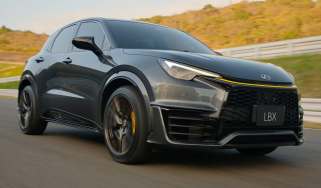Lexus ROV buggy concept revealed with hydrogen power
Powered by an experimental hydrogen-fueled combustion engine, the Lexus ROV buggy promises eco-friendly fun off the beaten track
Unveiled at the end of last year, Lexus brought its ROV off-road buggy concept to this year’s Tokyo Auto Salon. It previews a possible extension to the Lexus brand, as well as some experimental hydrogen technology that works on the same principles as a traditional combustion engine.
Lexus’ European boss, Spiros Fotinos, recently described the ROV as a car that was designed to “unlock a new kind of off-roading adventure for our customers in a true Lexus way” – and we’d say Lexus has the “off-road” part of that brief nailed down well.
It’s a small, two-seat buggy with a similar design to the Can-Am Maverick, sporting an exposed construction, long-travel suspension and chunky off-road tyres. It measures just 3.1 metres long and 1.7 metres wide – and its appearance has little in common with Lexus’ road cars, although the headlight design does hint at a connection.
The cabin is even less like a conventional Lexus, with exposed carbon-fibre trim, a leather steering wheel, a simple rev-counter and only a few switches. Also, the seats are trimmed in wipe-down synthetic leather upholstery, because they’re designed to get dirty.
While these off-the-wall design choices are certainly interesting from a brand such as Lexus, the real significance of the vehicle is its choice of powertrain. It uses a 1.0-litre three-cylinder combustion engine that’s fuelled by hydrogen, fed from a high-pressure storage tank.
Lexus has yet to confirm any performance specifications, although the brand says the fast-burning hydrogen produces plenty of torque. As an added benefit, Lexus also claims the engine consumes far less oil than a conventional petrol-powered engine.
The transmission is a sequential paddle-shift unit, with three drivetrain settings. Using a rotary switch on the centre console, the driver can choose to run the car in two-wheel drive, four-wheel drive or with the differential locked.
Lexus says the ROV’s main emission is water, just like a hydrogen fuel cell – but the brand admits there are “marginal levels” of CO2 and NOx. But the brand holds firm on the car’s eco credentials – and Fotinos told Auto Express that this solution would, in theory, allow the car to appeal to the growing trend for rural exploration, while maintaining credible sustainability.
Engineers chose to use a combustion engine instead of a fuel cell on the grounds of cost, packaging, weight and technical complexity. Lexus also says the decision means the ROV maintains the “excitement made only possible through the vibrations of an engine-powered vehicle.”
Lexus has no plans to produce the ROV – but the firm does have a history of experimenting with extensions to its brand and then taking them to the manufacturing level after positive customer feedback. A couple of years ago, the company designed a yacht and subsequently put the vessel into production as the LY 650.
Now check out the latest Stellantis plans for a hydrogen van…
Find a car with the experts








